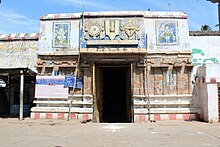
The Ashtabujakaram or Ashtabuja Perumal Temple located in Kanchipuram in the South Indian state of Tamil Nadu, is dedicated to the Hindu god Vishnu. Constructed in the Dravidian style of architecture, the temple is glorified in the Nalayira Divya Prabandham, the early medieval Tamil canon of the Alvar saints from the 6th–9th centuries CE. It is one of the 108 Divya Desams dedicated to Vishnu, who is worshipped as Ashta Bhuja Perumal and his consort Lakshmi as Alamelumangai.

The Deepaprakasa Perumal Temple, also referred to as Tiruththanka, and Tooppul, is located in Kanchipuram in the South Indian state of Tamil Nadu, is a temple dedicated to the Hindu god Vishnu. Constructed in the Dravidian style of architecture, the temple is glorified in the Naalayira Divya Prabandham, the early medieval Tamil canon of the Alvar saints from the 6th–9th centuries CE. It is one of the 108 Divya Desams dedicated to Vishnu, who is worshipped as Deepaprakasar, and his consort Lakshmi as Maragathavalli.

Hara Saabha Vimochana Perumal Temple in Thirukandiyur, a village in the outskirts of Thiruvayaru in the South Indian state of Tamil Nadu, is dedicated to the Hindu god Vishnu. Constructed in the Dravidian style of architecture, the temple is glorified in the Nalayira Divya Prabandham, the early medieval Tamil canon of the Alvar saints from the 6th–9th centuries CE. It is one of the 108 Divya Desam dedicated to Vishnu, who is worshipped as Hara Saabha Vimochana Perumal and his consort Lakshmi as Kamalavalli Nachiyar.

Nachiyar Kovil or Thirunarayur Nambi Temple is a Hindu temple in Thirunarayur, a village in the outskirts of Kumbakonam in the southern Indian state of Tamil Nadu, is dedicated to the Hindu god Vishnu and his wife Lakshmi. It is the sub urban region of business city of Kumbakonam.
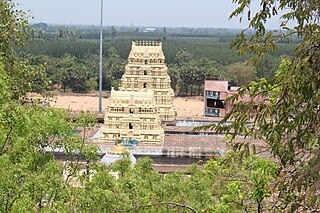
Devanatha Hemabhujavalli Temple is a Hindu temple in Thiruvanthipuram, a village in the outskirts of Cuddalore in the South Indian state of Tamil Nadu, dedicated to the god Vishnu and goddess Lakshmi. Constructed in the Dravidian style of architecture, the temple is glorified in the Nalayira Divya Prabandham, the early medieval Tamil canon of the Alvar saints from the 6th–9th centuries CE. It is one of the 108 Divya Desams dedicated to Vishnu, who is worshipped as Devanatha and Lakshmi as Hemabhujavalli. Though the presiding deity is Devanatha and Hemabhujavalli, the temple is known for Hayagriva, the ninth avatara of Vishnu in the Dashavatara of Vishnu and a god of knowledge. The temple is the only historical temple in South India to have a shrine of Hayagriva on hilltop.

Tirupavalavannam or Pavalavanam temple located in Kanchipuram in the South Indian state of Tamil Nadu, is dedicated to the Hindu god Vishnu. Constructed in the Dravidian style of architecture, the temple is glorified in the Nalayira Divya Prabandham, the early medieval Tamil canon of the Alvar saints from the 6th–9th centuries CE. It is one of the 108 Divya Desams dedicated to Vishnu, who is worshipped as Pavalavannar Perumal and his consort Lakshmi as Pavalavalli.

Kazheesirama Vinnagaram or Tadalan Kovil or Tiruvikrama (trivikara) Perumal Temple is a temple dedicated to Vishnu located in Sirkazhi, Tamil Nadu, India. Constructed in the Dravidian style of architecture, the temple is glorified in the Nalayira Divya Prabandham, the early medieval Tamil canon of the Alvar saints from the 6th–9th centuries CE. It is one of the 108 Divya Desam dedicated to Vishnu, who is worshipped as Trivikrama and his consort Lakshmi as Loganayagi. The temple is believed to have been built by Cholas, with later contributions from Medieval Cholas, Vijayanagara kings, and Madurai Nayaks.
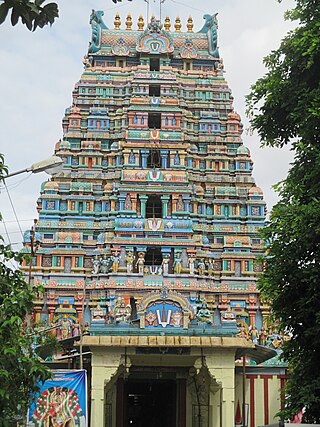
The Soundararajaperumal Temple is a temple dedicated to the Hindu god, Vishnu. It is located in Nagapattinam, a town in the South Indian state of Tamil Nadu. Constructed in Dravidian style of architecture, the temple is glorified in the Nalayira Divya Prabandham, the early medieval Tamil canon of the Alvar saints from the 6th–9th centuries CE. It is counted as one among the 108 Divya Desams dedicated to Vishnu. Vishnu is worshiped as Soundararaja Perumal and his consort Lakshmi as Soundaravalli.

Thirukkavalampadi or Gopalakrishna Perumal Temple is located in Thirunangur in the South Indian state of Tamil Nadu. It is dedicated to the Hindu god Vishnu. Constructed in the Dravidian style of architecture, the temple is glorified in the Nalayira Divya Prabandham, the early medieval Tamil canon of the Alvar saints from the 6th–9th centuries CE. It is one of the 108 Divya Desams dedicated to Vishnu, who is worshipped as Gopalakrishnan and his consort Lakshmi in two forms as Rukmini and Satyabhama.

The Purushotama Perumal Temple is located in Thirunangur, a village in the outskirts of Sirkazhi in the South Indian state of Tamil Nadu, and is dedicated to the Hindu god Vishnu. Constructed in the Dravidian style of architecture, the temple is glorified in the Nalayira Divya Prabandham, the early medieval Tamil canon of the Alvar saints from the 6th–9th centuries CE. It is one of the 108 Divya Desams dedicated to Vishnu, who is worshipped as Purushottaman and his consort Lakshmi as Purushottama Nayagi.
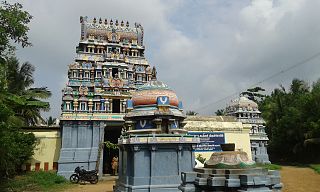
Thiruarimeya Vinnagaram or Kudamudakoothan Perumal Temple is dedicated to Hindu god Vishnu located in Tirunangur, a village in the outskirts of Sirkaḻi in the South Indian state of Tamil Nadu. Constructed in the Dravidian style of architecture, the temple is glorified in the Nalayira Divya Prabandham, the early medieval Tamil canon of the Alvar saints from the 6th–9th centuries CE. It is one of the 108 Divya Desams dedicated to Vishnu, who is worshipped as Kudamudakoothan and his consort Lakshmi as Amirtagadavalli.
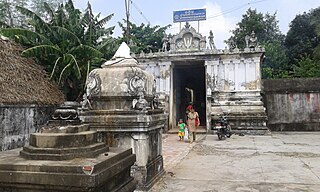
Thiruchsemponsey or Perarulaalan Perumal Temple is dedicated to Hindu god Vishnu located in Thirunangur, a village in the outskirts of Sirkazhi in the South Indian state of Tamil Nadu. Constructed in the Dravidian style of architecture, the temple is glorified in the Nalayira Divya Prabandham, the early medieval Tamil canon of the Alvar saints from the 6th–9th centuries AD. It is one of the 108 Divya Desam dedicated to Vishnu, who is worshipped as Peralulalan and his consort Lakshmi as Allimalar Nachiyar.

Thirumanimadam or Narayanan Perumal Temple is dedicated to Hindu god Vishnu located in Thirunangur, a village in the outskirts of Sirkazhi in the South Indian state of Tamil Nadu. Constructed in the Dravidian style of architecture, the temple is glorified in the Nalayira Divya Prabandham, the early medieval Tamil canon of the Alvar saints from the 6th–9th centuries CE. It is one of the 108 Divya Desams dedicated to Vishnu, who is worshipped as Narayanan and his consort Lakshmi as Pundarikavalli.

Thiruthevanartthogai or Madhava Perumal Temple is a Hindu temple dedicated to Vishnu located in Tirunangur, a village in the outskirts of Sirkaḻi in the South Indian state of Tamil Nadu. Constructed in the Dravidian style of architecture, the temple is glorified in the Nalayira Divya Prabandham, the early medieval Tamil canon of the Alvar saints from the 6th–9th centuries CE. It is one of the 108 Divya Desams dedicated to Vishnu, who is worshipped as Madhava Perumal and his consort Lakshmi as Kadalmagal.
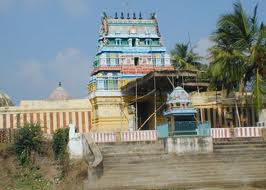
Thiruvellakkulam is a Hindu temple dedicated to Vishnu located in Thirunangur, a village in the outskirts of Sirkazhi in the South Indian state of Tamil Nadu. Constructed in the Dravidian style of architecture, the temple is glorified in the Nalayira Divya Prabandham, the early medieval Tamil canon of the Alvar saints from the 6th–9th centuries CE. It is one of the 108 Divya Desams dedicated to Vishnu, who is worshipped as Annan Perumal and his consort Lakshmi as Alamermangai.

The Naanmadiya Perumal Temple is a Hindu temple situated in the village of Thalaichangadu, near Akkur in Mayiladuthurai district in the South Indian state of Tamil Nadu. Constructed in the Dravidian style of architecture, the temple is glorified in the Nalayira Divya Prabandham, the early medieval Tamil canon of the Alvar saints from the 6th–9th centuries CE. It is one of the 108 Divya Desams dedicated to Vishnu, who is worshipped as Nanmadiya Perumal and his consort Lakshmi as Talaichanga Nachiar.
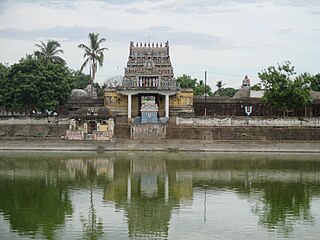
The Bhaktavatsala Perumal Temple is a temple dedicated to Hindu god Vishnu, located in Thirukannamangai, a village in Tiruvarur district in the South Indian state of Tamil Nadu. Constructed in Dravidian style of architecture, the temple is glorified in the Nalayira Divya Prabandham, the early medieval Tamil canon of the Alvar saints from the 6th–9th centuries CE. It is counted as one among the 108 Divya Desams dedicated to Vishnu. Vishnu is worshipped as Bhaktavatsala Perumal and his consort Lakshmi as Kannamangai Nayagi.
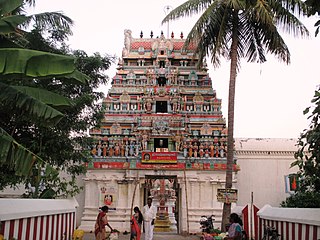
Nathan Kovil or Thiru Nandipura Vinnagaram Temple in Nathan Kovil, a village in the outskirts of Kumbakonam in the South Indian state of Tamil Nadu, is dedicated to the Hindu god Vishnu. Constructed in the Dravidian style of architecture, the temple is glorified in the Nalayira Divya Prabandham, the early medieval Tamil canon of the Alvar saints from the 6th–9th centuries CE. It is one of the 108 Divya Desams dedicated to Vishnu, who is worshipped as Jagannathan and his consort Lakshmi as Shenbagavalli.

The Alagiyasingar Temple in Thiruvali, a village in Mayiladuthurai district in the South Indian state of Tamil Nadu, is dedicated to the Hindu god Vishnu. Constructed in the Dravidian style of architecture, the temple is glorified in the Nalayira Divya Prabandham, the early medieval Tamil canon of the Alvar saints from the 6th–9th centuries CE. It is one of the 108 Divya Desams dedicated to Vishnu, who is worshipped as Alagiyasingar and his consort Lakshmi as Purnavalli.

Nilathingal Thundam Perumal temple is a Hindu temple dedicated to Vishnu, located in Kanchipuram in the state of Tamil Nadu, India. The temple is located in a shrine in Ekambareswarar Temple, the largest temple in the town of Kanchipuram, located in the northern part of the town. The temple gopuram is 59 m tall, which is one of the tallest gopurams in India.
